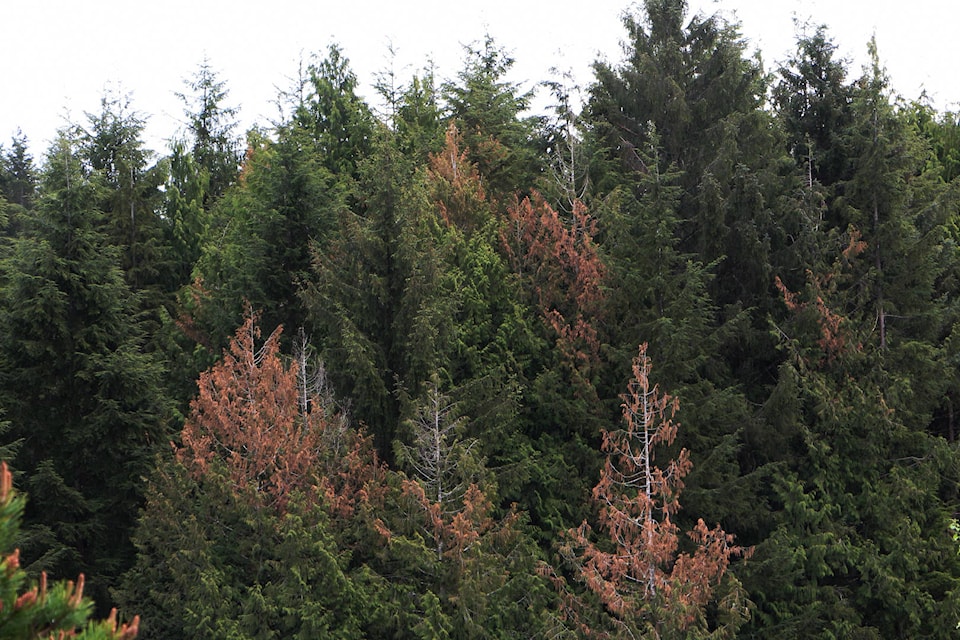During the golden hour when the sun is about to set over the mountains of Prince Rupert, the yellowish-gold outlines of trees can be seen on the horizon. About half of those trees are red cedar. Inside them nest bats, owls, and other birds who use their cavities as shelter. But the trees closer to the edge of the highway, exposed to the city’s boundaries, are not so beautiful. They are slowly dying from the top-down, turning a yellowish-brown that will remain there until the drought season ends.
“With drought, comes a lot of stress on the trees,” said Amanita Coosemans, a plant ecologist in Terrace.
The red cedar tree, adopted as the official tree of British Colombia on February 18, 1988, thrive best in wet environments and are now decaying from the current drought season. Although Prince Rupert is one of the rainiest cities in Canada, the current amount of rain in the city is still not enough to keep them alive.
Coosemans said that red cedars are highly adaptable to their environment, meaning the trees in the area have grown accustomed to the previous amounts of rain.
“They need a lot of consistency in their environment,” she said.
Prince Rupert has been below the average rainfall in the past four months, three of which have been significantly low, according to Gregg Walters, meteorologist for Environment Canada.
READ MORE: Rupert received less than a quarter of average rainfall last month
The climate observation facility on Digby Island has recorded a 75 per cent decline in precipitation (rain and snow) for the months of February and April. Currently, in May, we are only at a 15 per cent level of perception from normal levels.
“The seasonal forecast is hit and miss,” he said about the upcoming summer months forecast.
The trees contribute more than one billion dollars to the provincial economy, according to a 2018 economic assessment of red cedars in British Columbia, by Natural Resources Canada.
| Data and charts from Canada Forestry Services |
Cedar trees are also inherent to Indigenous culture in the North Pacific region. Art Sterritt, a local Tsimshian Indigenous artist in Prince Rupert, said he uses the resource for all his artwork, such as totem poles.
“The cedar tree really is everything to the Haida, Tsimshian, and the foundation for all Indigenous cultures in this region,” he said. “Just about everything you can name cedar was used for.”
The red cedar has historically been used for transportation, clothing, housing, and fish traps and many more household items.
“Without cedar the culture just wouldn’t be what it is,” he said. “It’s what made them so strong. You can’t build the kind of structures that the Haida, Tsimshian, and other coastal nations could without it.”
Today, the red cedar is not used as widely to build canoes and other structures, but Sterritt said all the major art pieces – such as the totem poles that represent the four clans; eagles, wolves, ravens, and the black fish (killer whales) – are made with red cedar.
Drought is not the only threat to the tree. Millions of cedars have been logged out of the forest. The natural oils in the wood allow them to last a long time and they are strong enough to build big structures.
“It’s hard to come by good cedar now because of the economy,” Sterritt said. “[The good ones] can be found along creeks and rivers but obviously climate change is going to change that. There’s been pressure put on that wood.”
READ MORE: Heart of Our City: Cedar wood therapy
Coosemans said we can be almost certain the cause of the deaths is from the drought because of the location. Only the trees exposed closer to the highway have been affected. Trees exposed in the open are more likely to feel the effects of a drought. Fortunately this means, for the millions of trees housed in the mountains, they are safe for the time being.
Another telltale sign that the drought is to blame for the dying trees is the direction of dead leaves – top-down. Coosemans said if the cause was root rot than we would be seeing trees dead on one side, where the infected root is.
Coosemans said while more heavily populated urban areas can mitigate the problem by watering the trees, she said that is unlikely in an area like Prince Rupert with so thousands of cedar trees, less resources, and trees that are harder to access. Red cedars are not the only trees facing death from drought. In Terrace, Coosemans has noticed dying hemlocks and amabilis firs.
“We have only been through one drought season so far so I am pretty hopeful they will survive,” said Coosemans. “But they can’t take too many more years in this climate.”
Send Jenna email
Like the The Northern View on Facebook
Follow us on Twitter
